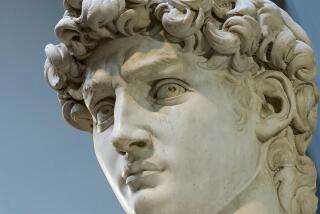Getty exhibit illustrates the story of David
- Share via
The story of David, the shepherd boy who slew the Philistine Goliath, became the divinely chosen king of the Israelites and seduced Bathsheba, would be compelling in any era.
But for medieval Christians, the poet, harpist and warrior assumed immense importance as an exemplar of piety and penitence, an Everyman on whom they could model their own commitment to God.
So large loomed his legend that throughout the Middle Ages David was credited with being the author of the 150 Psalms, the deeply affecting “songs of praise” initially composed in Hebrew, that were incorporated into the Hebrew Bible and later the Christian Bible.
The Psalms played a vital role in medieval devotion from about 500 to the 1500s, and David’s image appears in lavishly illustrated Psalters, volumes containing the Book of Psalms, and choir books of the period. Many of these manuscripts, painted in brilliant hues and decorated with gold leaf, are on view through Aug. 16 in the Getty Museum’s North Pavilion.
In an era of e-books, it is impressive to see the enduring beauty of the 21 manuscripts and leaves, or individual pages, displayed in “Temptation and Salvation: The Psalms of King David.” All of the examples -- some large, some tiny -- were drawn from the Getty’s own collection of the illustrated texts, inaugurated in 1983 with the purchase of 144 manuscripts owned by German chocolate magnate Peter Ludwig and his wife, Irene.
The manuscripts’ power lingers today in part because most were penned, often with goose feather quills, on vellum instead of paper or papyrus. Vellum, a high-quality parchment made from the scraped skins of calves, sheep or goats, was firm yet flexible and held pigments nicely, allowing the documents to withstand daily wear and tear.
According to Getty experts, the manuscript texts were usually written in ink containing ferrous sulfate and gum arabic. Once applied to vellum, the ink turned brownish as it oxidized.
Because the documents are light-sensitive, they are displayed in a nearly dark exhibition room. Nonetheless, many of them sparkle, appearing to be 3-D thanks to the gold leaf and other shiny substances used by lay illuminators. Several of the illustrations feature elaborate blossoms and vines, intricately drawn in ink and colored with tempera shades such as vermilion, made from mercury and sulfur, and ultramarine blue, created by crushing lapis lazuli.
Many images appear within the large or small initial letters that introduce passages of the text. A 13th century Latin Psalter features an illustrated “D” that opens Psalm 39: “I said: ‘I will guard my ways, that I may not sin with my tongue; I will keep a muzzle as long as the wicked are in my presence.’ ”
David is shown pointing to his mouth, indicating his desire to avoid any sinful slips of the tongue. An angel guards him above while a demon tugs on his robe below, reflecting the inner struggle between good and evil.
“David in many ways was a symbol of what we would call an integrated person,” said Father Luke Dysinger, a Benedictine monk at St. Andrew’s Abbey in Valyermo, Calif. “He was aware of his gifts and his limitations, which is to say both his sinfulness and capacity for virtue.”
For sins, it would be difficult to top David’s seduction of Bathsheba, the wife of the soldier Uriah, and the king’s subsequent order that Uriah be placed on the front lines of a battle, where he was killed.
In a double-page spread with small illustrations by an unknown German artist from the early 1400s, David is shown bursting in on Bathsheba as she bathes and then dining with Uriah, who is unaware that the lustful king is plotting to eliminate him.
The viewer witnesses David’s surrender to sin, for which he spent much of the rest of his life atoning.
“David stumbled in his attempt to lead the good life . . . but was constantly repenting and searching for forgiveness,” said Kristen Collins, the Getty’s associate curator of manuscripts. “His personal redemption foretold the redemption of all mankind through Christ.”
Introducing the show is a large 15th century manuscript leaf from the Antiphonal of Cardinal Bessarion, a volume of chants with illumination attributed to the Italian Franco dei Russi. Meant to be viewed by a group of singers, it shows David kneeling with his psaltery, a harp-like instrument. A small, ghostly figure, representing David’s soul, stands in the palm of his hand, and he is lifting it up to God.
Volumes with pages that could be turned were a medieval invention, an improvement on the scrolls of ancient times. To be called literate, one needed to be able to recite Latin with proper pronunciation, and medieval people learned to read by reciting the Psalms. Monks and clerics, meanwhile, were required to recite the Book of Psalms throughout the liturgical day.
“There’s no way of overestimating how important the Psalms were in medieval religious life,” said Kathryn A. Smith, an associate professor of art history at New York University, who will present a lecture at the Getty on Wednesday.
For many medieval Christians, the illustrations of David provided a guide for following their own paths to forgiveness and salvation, said John Goldingay, a professor of Old Testament at Fuller Theological Seminary in Pasadena. “That was their way of identifying with and reflecting on those texts.”
--
More to Read
The biggest entertainment stories
Get our big stories about Hollywood, film, television, music, arts, culture and more right in your inbox as soon as they publish.
You may occasionally receive promotional content from the Los Angeles Times.











